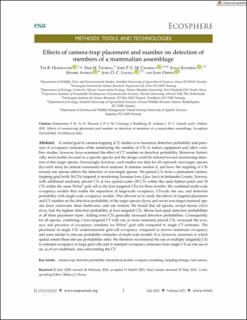| dc.description.abstract | A central goal in camera-trapping (CT) studies is to maximize detection probability and precision of occupancy estimates while minimizing the number of CTs to reduce equipment and labor costs. Few studies, however, have examined the effect of CT number on detection probability. Moreover, historically, most studies focused on a specific species and the design could be tailored toward maximizing detection of this target species. Increasingly, however, such studies use data for all captured, non-target, species (by-catch data) for animal community-level analyses. It remains unclear if, and how, the targeting of CTs toward one species affects the detection of non-target species. We paired CTs from a permanent camera-trapping grid (with 38 CTs) targeted at monitoring Eurasian lynx (Lynx lynx) in Innlandet County, Norway, with additional randomly placed CTs at two spatial scales (38 CTs within the same habitat patch and 38 CTs within the same 50-km2 grid cell as the lynx-targeted CTs) for three months. We combined multi-scale occupancy models that enable the separation of large-scale occupancy, CT-scale site use, and detection probability with single-scale occupancy models. This allowed us to study the effects of targeted placement and CT number on the detection probability of the target species (lynx) and seven non-target mammal species (four carnivores, three herbivores, and one rodent). We found that all species, except moose (Alces alces), had the highest detection probability at lynx-targeted CTs. Moose had equal detection probabilities at all three placement types. Adding extra CTs generally increased detection probabilities. Consequently, for all species, combining a lynx-targeted CT with one or more randomly placed CTs, increased the accuracy and precision of occupancy estimates for 50-km2 grid cells compared to single CT estimates. The placement of single CTs underestimated grid-cell occupancy compared to known minimum occupancy and were similar to site-use probability estimates of multi-scale models. It is, however, uncertain to which spatial extent these site-use probabilities refer. We therefore recommend the use of multiple (targeted) CTs to estimate occupancy in large grid cells and to interpret occupancy estimates from single CTs as site use of an, as of yet undefined, area surrounding the CT. | en_US |

